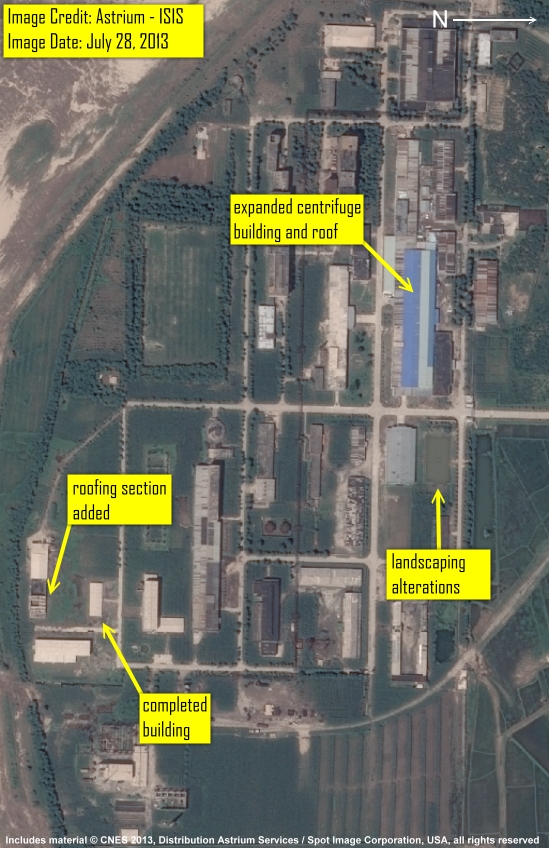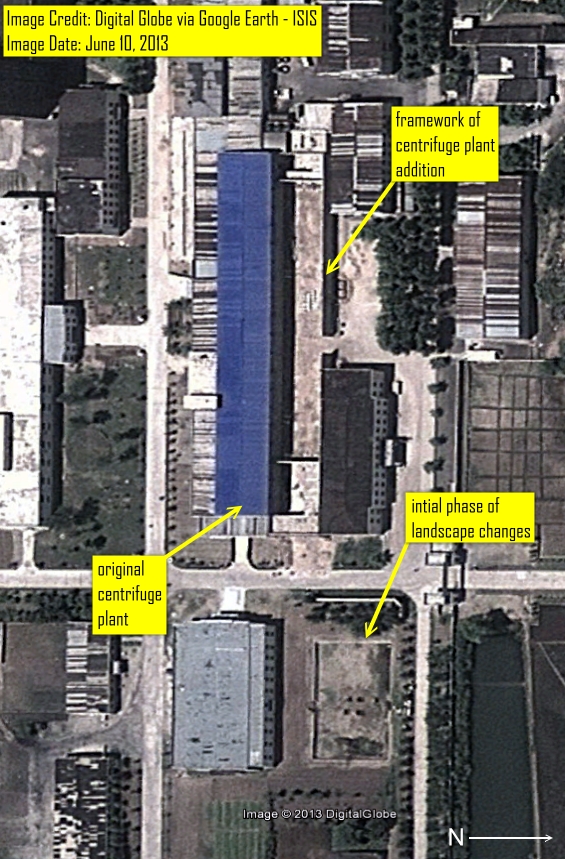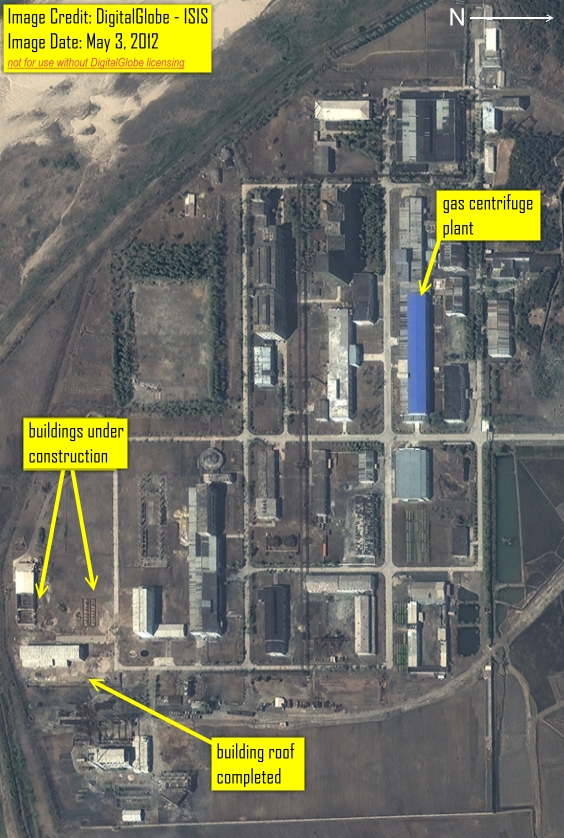Reports
Recent Doubling of Floor Space at North Korean Gas Centrifuge Plant : Is North Korea doubling its enrichment capacity at Yongbyon?
by David Albright and Robert Avagyan
August 7, 2013
Recent satellite imagery of the Yongbyon nuclear complex in North Korea indicates that it has apparently expanded a building in the fuel fabrication complex that houses a gas centrifuge plant for uranium enrichment. The area is now covered by an extended roof that is roughly twice the size of the previous one (figures 1, 2, and 3).
According to North Korea, the plant has produced low enriched uranium (LEU), ostensibly to fuel the experimental light water reactor under construction at the Yongbyon complex. The extent of North Korea’s centrifuge enrichment infrastructure is not fully known, and it is possible that some LEU produced in this facility could have been further enriched at a secret centrifuge site to produce weapon-grade uranium. Or weapon-grade uranium could have been made at the Yongbyon plant. A significant question remains whether North Korea has made weapon-grade uranium, and if so, how much it has made. 1
Based on the analysis of ISIS archival satellite imagery and imagery available on Google Earth, construction of the centrifuge building extension appears to have begun sometime in March 2013 (figures 2 and 3) preceding shortly the announcement by the North Korean government that it planned on “readjusting and restarting all the nuclear facilities in Yongbyon including uranium enrichment plant and 5MW graphite moderated reactor“. This announcement may have been partially intended as an oblique effort to reveal this new construction; one missed publicly at the time.
The new addition to the centrifuge plant matches the overall length and width of approximately 120 x 15 square meters of the original building, effectively doubling its size. Google Earth imagery from June 10, 2013 reveals the internal floor plan of the new addition which is divided into three sections with two smaller rooms of 18x15 m2 and 9x15m2 and a larger hall of 93x15m2 (figure 2). The larger hall appears to be a cascade hall, where the centrifuges would be located.
A doubling of available floor space at this building could allow a doubling of the number of centrifuges installed there. North Korea stated in 2010 that the plant contained about 2,000 centrifuges with an enrichment output of 8,000 separative work units (swu) per year. Thus, North Korea could in theory install 2,000 more centrifuges for a total of 4,000 centrifuges with a total declared capacity of 16,000 swu per year in this expanded building. ISIS has previously assessed that North Korea could have procured enough raw materials and equipment, many acquired from abroad, to build and install that number of centrifuges. 2
Weapon-Grade Uranium Production
Estimating North Korea’s level of uranium enrichment, in particular estimating the amount of weapon-grade uranium it has produced, is fraught with uncertainty. A key uncertainty is whether the Yongbyon centrifuge plant is North Korea’s only such plant. Another problem is the lack of information about the operational performance of the Yongbyon centrifuge plant, and particularly the centrifuge performance there which, could vary greatly. Reflecting this uncertainty, ISIS assessed that through 2012, North Korea could have produced enough weapon-grade uranium for anywhere from 0-13 nuclear weapons. 3
ISIS has estimated that the annual production of weapon-grade uranium (WGU) at the Yongbyon plant could have varied greatly from 4 to 17 kilograms of WGU per year per 1,000 P2-type centrifuges, with a mid-point of 11 kilograms of WGU per year per 1,000 P2 centrifuges. 4 A doubling of capacity from 2000 to 4000 centrifuges would mean that annual WGU production could increase from 8 to 34 kilograms to 16 to 68 kilograms. However, much of the enrichment output of this plant is needed to make LEU for the experimental light water reactor, thus a more realistic estimate is that doubling the capacity would allow for an increase in the production of enough weapon-grade uranium for up to two nuclear weapons per year, estimating that each weapon would require approximately 20 kilograms of weapon-grade uranium. As mentioned previously however, it is not known if North Korea intends to produce weapon-grade uranium in this facility.
Signs of Additional Construction near Centrifuge Plant
There are also signs of construction or landscaping in an area adjacent to the centrifuge plant. A previously empty lot was cleared and converted into what appears to be a pool. However, it is not clear if this activity is functionally related to the expansion of the centrifuge plant building (figures 1 and 2).
Other Construction at Fuel Fabrication Complex
Over the past year there has also been ongoing construction at several buildings within the southeastern corner of the fuel fabrication facility perimeter; two new buildings have been constructed, and a third building is in the process of being slowly roofed (figures 1 and 3). These new buildings are suspected to be related to fuel production for the experimental light water reactor.



1 By David Albright and Christina Walrond, North Korea’s Estimated Stocks of Plutonium and Weapon-Grade Uranium, ISIS Report, August 16, 2012. http://isis-online.org/uploads/isis-reports/documents/dprk_fissile_material_production_16Aug2012.pdf 2 Ibid. 3 Ibid. See table 5, where the value is 0-11 through 2011. 4 Ibid.

 twitter
twitter